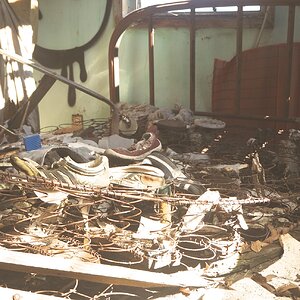2framesbelowzero
TPF Noob!
- Joined
- Mar 24, 2006
- Messages
- 300
- Reaction score
- 1
Zeabned said:Agfa is the first down; and I understand that Ilford's survival has been a near-run thing.
Here is a quote from some correspondence with Agfa..(Aug 2005)
Scala 120 will be phased out this year. Scala 135-36 will be phased out during 2006. AgfaPhoto will continue to produce the following 35 mm films: Agfacolor Vista 200 & 400, Agfacolor Optima Prestige 100, 200 & 400, Agfacolor Portrait 160, Agfachrome RSX 100, Agfachrome Precisa 100 and Agfapan APX 100 & 400.
-------
And the deal from Harman Technology ...
Ilford Photo plan for B&W future
(18:03:51 - 10th Mar 05)
As well as continuing production of established products Ilford Photo are also planning to re-introduce some discontinued items
Howard Hopwood, one of the six members of the management team that have taken over Ilford Imaging Group’s UK arm, told Ian Andrews of ePHOTOzine today that Ilford would be ‘The last man standing’ where black & white products are concerned. Between the six members, there is over 130 years of experience in the business. Now trading as Ilford Photo, the management have formed the company Harman Technology Ltd, named after the Alfred Harman, who founded Ilford in 1879. After negotiations with the old company’s Swiss branch, whose own buy out should be completed in early May, Harman Technology will retain the Ilford name for all their B&W products.
The good news for photographers is that Ilford Photo will continue to produce almost all of their list of film stock, and have re-introduced their chemical products after the receivers stopped production. All of the liquid products are now available, and the powder products such as ID11, Microfen and Perceptol will be in constant supply within three months. “The one notable casualty is SFX200, which had a very low turnover anyway” said Howard.
Howard was keen to emphasise that the new company was free from debt and therefore free of pressure. “This gives us a good platform to focus on the right things” he said. The company have retained the 350-380 staff that were kept on by the receiver and they have a business plan that is robust enough to survive.
The company’s strength lies in thin layer coating, and there are many applications where this can be exploited. This type of thing will have to be marketed under the Harman Technology banner, following the agreement with the Swiss arm.
Ilford Photo are also contracted to supply coatings for the Swiss branch for the moment.
Ilford Photo are also planning to re-introduce some discontinued products and have been asked to produce coated Glass Plates as they are one of the only companies in the world with the technology to do so.
After only three weeks since the takeover, Howard is pleased with the way the future was shaping up.






![[No title]](/data/xfmg/thumbnail/42/42255-14c14cc733bc4ab5cd38a6fa6783ece1.jpg?1619740064)


![[No title]](/data/xfmg/thumbnail/32/32709-80f0f0432fd5ec548a3efdb60ef77d46.jpg?1619735613)

